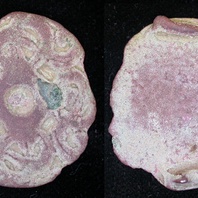
Viking Objects
Disc Brooch (LEIC-604DE5)
This example of an Anglo-Scandinavian copper-alloy disc brooch features a Borre-style knot design surrounded by a concave-sided lozenge motif. It has been classified as East Anglian Series Type I. For more information on Scandinavian jewellery in England check out our blog: Brooches, Pendants and Pins: Scandinavian Dress Accessories in England.
Read More
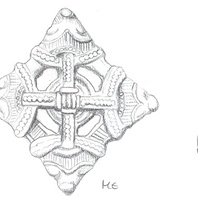
Viking Objects
Lozenge Brooch (NLM194)
This openwork Borre-style square brooch with animal heads on each corner was found in Elsham, Lincolnshire, in 1997. This type of brooch was an accessory for women wearing Scandinavian dress. For more information on Scandinavian jewellery in England check out our blog: Brooches, Pendants and Pins: Scandinavian Dress Accessories in England.
Read More
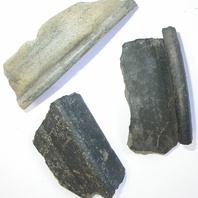
Viking Objects
Early Medieval Pottery Fragments (2001-59)
These are fragments of a Torksey ware rim, decorated Stamford ware rim, and a Stamford ware pot rim. Torksey ware was a type of pottery found in central England and dating to the period ad 850 to 1150. It was manufactured, initially by immigrant potters from Continental Europe, using a fast wheel at workshops around Torksey, Lincolnshire. While not having the same wide geographic distribution as Stamford ware, the popularity of Torksey ware in York was so high that it was initially thought that York was the original location of manufacture. Stamford ware is one of the earliest forms of lead-glazed ceramics in England, being produced in Stamford, Lincolnshire, between the ninth and thirteenth centuries and widely traded across Britain and the near continent. Early Stamford glazes were lead glazes, suggested by some to be unique among early English glazes since they contain traces of silver but not tin. The glaze could be of a pale yellow, orange, pale green, or smoke blue colour and was applied by using a brush.
Read More
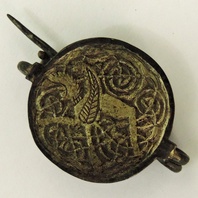
Viking Objects
Silver Gilt Brooch (1989-58/7224)
A circular silver gilt plate brooch with chip carved decoration of a winged creature. The creature may be a griffin. It is enmeshed in fine spiralling interlace. The reverse features a U-shaped catchplate and pin with a spring. This decoration is Mercian in style. For more information on Scandinavian jewellery in England check out our blog: Brooches, Pendants and Pins: Scandinavian Dress Accessories in England.
Read More
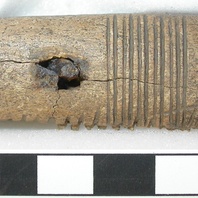
Viking Objects
Antler Comb (1986-976)
Fragments of an antler comb found on the site of Little Chester Roman fort (Derventio Coritanorum) in Derby. This comb is of Anglo-Scandinavian type. It consists of a flat plate of antler sandwiched between two strips of antler that are rounded on the exterior part. The whole is fixed together with an iron rivet. Nicks on the centre plate show that the teeth of the comb were cut after the three plates had been constructed and fixed.
Read More
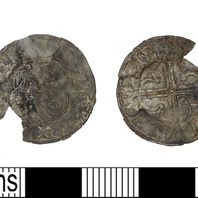
Viking Objects
Coin of Cnut the Great (LEIC-B1F8EA)
This coin is an example of a Quatrefoil type silver penny of Cnut, minted in Stamford or Norwich by the moneyer Thurstan. Minting coins was a way of controlling the means of exchange within a kingdom and one which created a more easily administered standardized system of trade. Moreover, the coins themselves were often used as propaganda, portraying symbols and statements that gave off a desired message. The Vikings later used the minting of coins to legitimise their own rule.
Read More
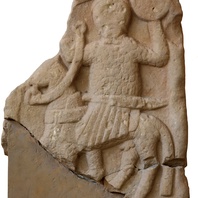
Viking Objects
Repton Stone (1989-59/1165)
The Repton Stone, as it is now known, was found in a pit near the eastern window of the Church of St Wystan, Repton, Derbyshire in 1979. It was originally carved on all four faces, but recognisable detail remains only on two of them. The Repton Stone is a section of a sandstone cross shaft carved on one side with a mounted armed figure (Face A), on the other with a monstrous creature eating the heads of two people (Face B). It was broken Face A: A moustachioed armed figure on horseback with sword and shield raised in the air is carved on this face. The horse is very clearly a stallion. Incised decoration, where the design is scratched into the surface, shows that the rider was depicted wearing armour and carrying a second weapon at his waist, perhaps a seax (knife or dagger). The armour was probably intended to be mail although the carving suggests scale. The mounted man appears to be wearing a diadem, suggesting that he was of high rank. He is wearing a pleated tunic under his armour, and has cross-gartered legs. The reins of the horse are looped over his right arm. Elements of the tack are clearly visible. Face B: This face would have been on the side of the cross. The monstrous creature on this face consists of a snake-like body with the face of a human being. The serpent beast appears to be devouring the heads of the two human figures that embrace in front of it. The serpent may be a representation of the Hellmouth devouring souls. The pit the stone was found in probably dates to the eleventh century or early twelfth century. However, the cross was probably much earlier in date, being broken up close to the time it was deposited in the pit. It is probable that the cross was made before the Viking camp in 873/4 because the monastery that stood on this site before the Vikings was not refounded after the Vikings adopted Christianity. The presence of this cross at the site of a Viking camp shows that Repton was an important place before the Vikings made it their temporary abode. This may have been one reason that the Vikings chose Repton for one of their camps, although its proximity to the River Trent would also have been an important factor. The Vikings used waterways to access the interior of the country, so it is not surprising to find their winter camps beside navigable rivers.
Read More
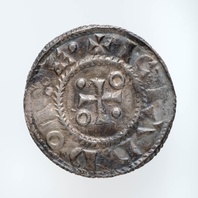
Viking Objects
Sihtric Caoch Silver Penny (CM.34-2000)
A sword and cross type silver penny of Sihtric Caoch (Sihtric Cáech) minted for the Viking kingdom of Northumbria. Sihtric Caoch was the Scandinavian ruler of Dublin from 917-920 CE and subsequently the ruler of Northumbria from 921-927 CE. It is not certain why he left Ireland. The Irish annals state that it was ‘through the grace of God’ and do not elaborate on the politics behind his departure. After the establishment of the Danelaw, some Viking leaders decided to mint their own coins to solidify their legitimacy in the eyes of the local populace. This created a hybrid economy where some members of the Danelaw used bullion and others used coins. This coin was part of a hoard of twelve coins found at Thurcaston between 1992 and 2000. The coins are Anglo-Saxon, Arabic and Viking issues, and show the diverse and wide-ranging contacts between societies at this time. The hoard was probably deposited c.923-925 CE, approximately five years after Leicester had been retaken by Mercia (c.918 CE). They indicate that a bullion economy was still operating in the Danelaw as late as the 920s. This suggests that the reconquest did not manage to institute Anglo-Saxon practices such as a monetary economy immediately.
Read More
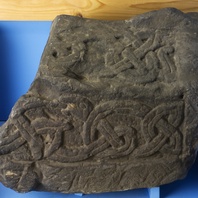
Viking Objects
St Alkmund’s Hogback Grave Marker (1996-60-5)
A stone hogback grave marker from St Alkmund’s Church, Derby. The site of St Alkmund’s Church is thought to have been on one of the oldest Christian sites in the area. Excavations on the site have shown that the church was in existence before the ninth century and that the presence of the Great Army in the ninth century seems to have led to a period of neglect and decay, before it was restored following the reconquest of the Danelaw in the tenth century or early eleventh century. Only about half of this hogback grave cover survives. It has the typical bear at the gable end, although the carving is damaged, and an interlaced serpent design within the panels on the side. It is typical of this type of grave cover which is found throughout northern England and into Scotland. They occur in Viking-dominated areas of the country, and appear to be an Anglo-Scandinavian tradition combining elements of pre-Christian and Christian iconography.
Read More
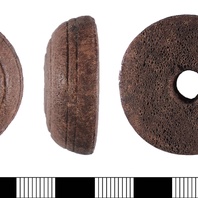
Viking Objects
Bone Spindle Whorl (LIN-9D24C2)
Fibres were spun into thread using a drop-spindle of which the whorls were made of bone, ceramic, lead, or stone and acted as flywheels during spinning. Other bone and ceramic spindle whorls with decorative circumference grooves are known from Anglo-Saxon sites elsewhere in areas such as West Stow, Suffolk.
Read More
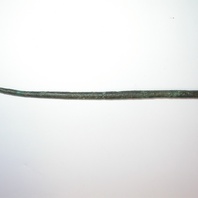
Viking Objects
Ring-headed Pin (1981/166-2568)
This copper alloy ring-headed pin was used for fastening cloaks and discovered during excavations at Full Street, Derby. Pins like this were common in Ireland and the western British Isles, and spread further afield under Viking influence.
